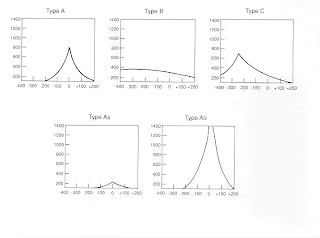Your Audiology Tutorial: Tympanometry

During a routine hearing exam battery, the audiologist may begin with what is known as tympanometry. It is an important measurement which gives the clinician an assessment of middle ear function. He or she will place a flexible plastic probe attached to a low tone generator which will measure how easily your eardrum (tympanic membrane) moves. The low frequency tone will vibrate the drum and a compliance measurement (admittance) will alert the clinician to a few things. Namely, that outer atmospheric pressure and Eustachian tube (runs between the eardrum and nasopharnyx) function are equal, or not. The tube opens and closes as you chew, yawn, change altitude, etc.
When the test is administered, the patient feels a "squeeze" in the ear canal. This is the result of a pressure seal created between the probe and the eardrum. A tymp measures ear canal volume, pressure, and drum motility. The results are designated by types (see above for graphical representation of each):
Type A: Normal E. tube function. Eardrum is moving normally with a pressure change.
Type B: Abnormal. Something is restricting the movement of the drum (likely fluid, but can also be/or ossification of the malleus, incus, and stapes bones[ossicular chain] that connect the drum to the inner ear, which would be classified as a Type As - shallow tymp). Children with fluid behnind their eardrums often have a flat or Type B tymp. The ear, nose, and throat doctor may place PE (pressure equalization) tubes in the child's ear to alleviate pressure and drain fluid.
Type C: The drum is moving but something is retracting it inwardly, toward middle ear space (could be negative pressure from the E. tube). Positive pressure can build up and do the reverse, pushing the drum outward. You can cause this by pinching your nostrils and exhaling with your mouth closed (Valsalva).
When a patient has a perforated (hole) eardrum, the measured canal volume may be quite large, as the measurement is going beyond the area between probe and drum and now into the middle ear via the perf. If the ossicular chain is disarticulated, the drum may beome flaccid (Type Ad-deep tymp).
Tympanometry is a quick, vital diagnostic that should be part of every audiometric examination.


Comments